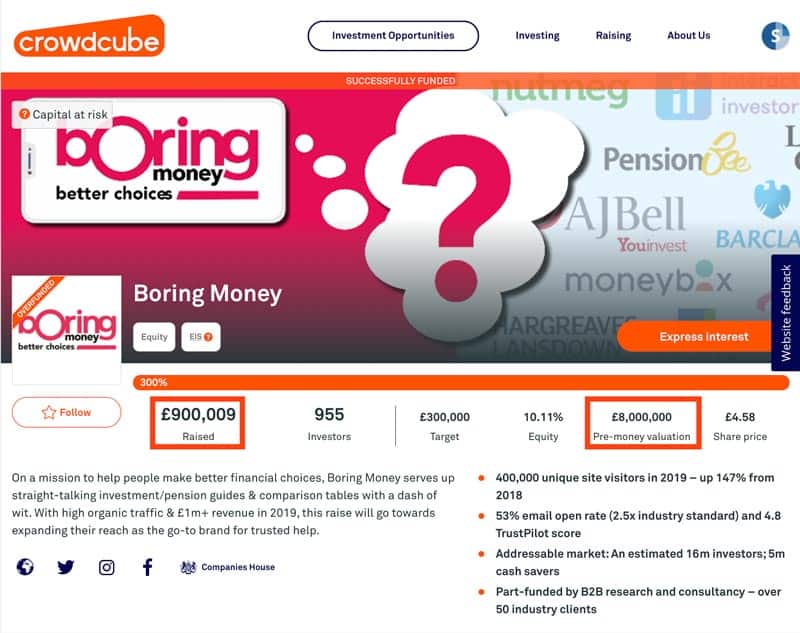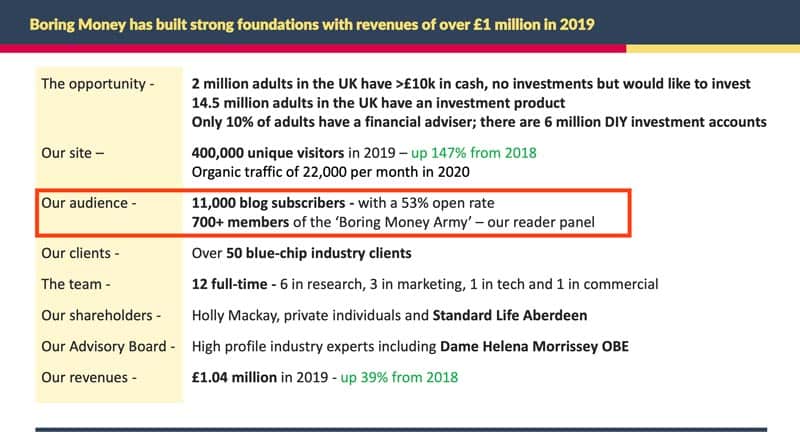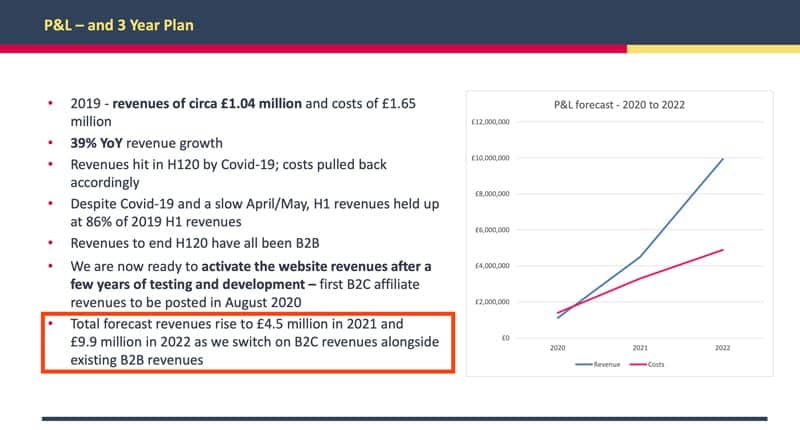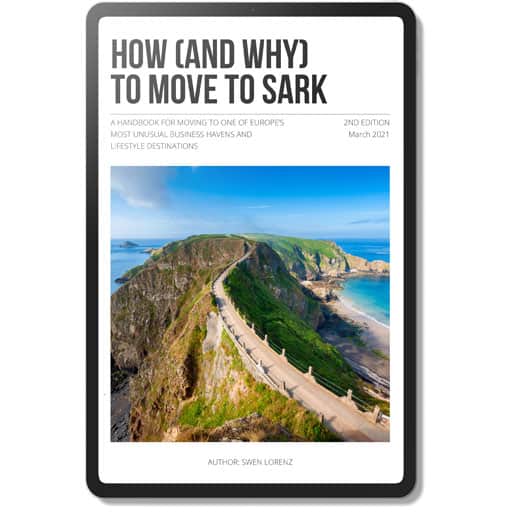I have been on a mission to talk people into setting up blogs, especially finance-related ones.
With success!
- A German equity analyst has just launched stock-market-research.com [1], which I take partial credit for.
- A 16-year old Italian with an interest in finance has launched almostseventeen.substack.com [2], also with my encouragement.
There are others, and I am delighted that they got inspired by my recent article “My top 10 rules for building a blog [3]”.
However, my article didn’t cover one crucial question.
“How on earth do you make money off a blog?”
It’s, literally, the million-dollar question.
The 2020s will present you with a chance to create your multi-million dollar blog operation, because of the massive shifts in the media landscape and consumer behaviour.
Read on to learn how to realistically make millions off a blog.
A widely underestimated profession
Blogging, and bloggers, still get laughed at.
I certainly got laughed at in 2018, when I decided to focus my time on building two blogs instead of looking for a new well-paid CEO job.
As I told friends back then, I wanted to create a blogging operation that generates USD 5m per year. I never specified whether that’d be revenue or profit. However, no one ever even asked. People thought the figure was so ludicrous that they didn’t enquire any further.
The 2020s will present you with a chance to create your multi-million dollar blog operation, because of the massive shifts in the media landscape and consumer behaviour.
Fast forward two short years, and it’s me who is laughing.
Whilst I have more work to do to reach my end goal, I already own a business that has low overhead, is entirely portable, and has profit margins that will make you blush.
As ever, people find excuses why they won’t get in on the game:
- “You’ve had 20 years of writing experience – I don’t.”
- “You are an exception, and blogging will never be a real business.”
- “You were just plain lucky.”
That’s one way of looking at it.
The other way is to look at models where it’s been done successfully and to then learn from them.
Whilst I have more work to do to reach my end goal, I already own a business that has low overhead, is entirely portable, and has profit margins that will make you blush.
It’s not just me who makes decent money of blogging. Let me introduce you to Boring Money, a UK finance website that also started as a blog.
Lateral thinking to create income streams
Boring Money helps people make better financial choices. It’s aimed at a UK audience and likes to describe itself as the “financial lovechild of Tripadvisor and Which?”.
You can argue whether Boring Money is a blog or not. It’s a financial comparison website, but it also has a blog with 11,000 readers at its core. Call it a website, a blog, or whatever you like – it’s an online publishing operation set up on a shoestring budget. Its founder, journalist Holly Mackay, is a regular contributor to the Financial Times, The Times, and the Mail on Sunday. She is also very much the public face of Boring Money.
Boring Money recently set out to raise GBP 300,000 to fund its growth.
In the end, it got GBP 900,000 from investors – three times what it had aimed to raise!

Set up in 2015, Boring Money was valued at GBP 8m. Presumably, the founder owns the largest chunk of that.
Not bad for such a young website!
What’s Boring Money’s secret sauce?
700 of its 11,000 blog subscribers are “super users”. They serve on panels, and help Boring Money generate industry intelligence about what private savers and investors are looking for.

Boring Money repackages this intelligence into research reports, which are then sold on to the likes of Fidelity, Vanguard, and HSBC. These large financial institutions are only too happy to between GBP 5,000 (USD 6,500) and GBP 15,000 (USD 19,000) for a single report (view a sample research report here [4]).
It’s a different kind of model for monetising blog readers, but it works. In 2019, Boring Money generated over GBP 1m in revenue, the largest part of which came from B2B transactions. The company can afford to offer high-quality information to the public for free because it makes most of its money from large corporations.

Besides www.boringmoney.co.uk [5] itself, Holly Mackay also operates www.boringmoneybusiness.co.uk [6] to sell the industry intelligence to corporate clients.
Speak of creative ways to monetise a website’s audience!
Which is the entire point.
To quickly get your blog income off the ground, you need to think outside the box.
Much as there is money to be made from run-off-the-mill subscription models or maybe even advertising, it pays to come up with entirely new ways for monetising attention.
If you do, you might not just become a millionaire – but possibly even a billionaire.
To quickly get your blog income off the ground, you need to think outside the box.
That’s not me saying this, but an incredibly insightful article that went viral the other week. If you haven’t read it yet, it’s really worth a close look.
“The Billion Dollar Blog”
This article about billion-dollar blogs [7] cited the example of Emily Weiss, a young fashion assistant at Vogue who started her blog in 2010: www.intothegloss.com [8]
Ten years on, what’s the blog worth?
A staggering USD 1.2bn.
That’s BILLION, not million.
As ever so often with successful blogs, the original website evolved into something entirely different and bigger. Out of the blog grew Glossier, the groundbreaking beauty brand.
Weiss had recognised the power of having an audience. It’s all about having the attention of an audience that trusts you, likes you, and is willing to buy products off you.
As Nathan Barry, the author of the article, put it:
“At first Emily’s story seems like an incredible outlier: a billion-dollar company born from a blog? How many times has that really happened? More often than you might think.”
Owning an audience is digital gold. With a blog, you can mine digital gold and create wealth out of nowhere.
It’s best if you read Barry’s article yourself. I’ll just give you his four rules for building truly astonishing fortunes on the back of a blog:
Rule #1: Build more than a personal brand
Rule #2: Sell products, not attention
Rule #3: Drive higher customer value through recurring or repeat purchases
Rule #4: Choose a better business model
The #1 thing to learn from Barry’s article? At the risk of repeating myself, you must think outside the box.
A real-life example for out-of-the-box thinking
For a long time, my very own blog seemed to have lacked a conventional focus or ambition to monetise its audience. Its content made it seem like a difficult blog to generate revenue from.
However, I had always planned to use www.swen-lorenz.com [9] as a launch pad for an unusual product. To my knowledge, no one had ever used a blog to relaunch an ailing jurisdiction on the international stage – and make money off it, too.
Enter “Sark Society [10]”, an information product aimed at helping people move to the island of Sark in the English Channel. I only launched this product in late August, and it’s already been a considerable success in many ways, including from an income point of view. A Sark Society membership currently costs EUR 1,400 (USD 1,650), and consists mostly of content and advice, which makes for attractive margins once you get a critical mass of clients.
You’ve got to be innovative and do things differently from everyone else.
If you succeed at that, you may end up building a billion-dollar operation on the back of a blog. Or, more realistically, you could build a smaller business that sustains an extraordinarily good lifestyle for yourself and secures your financial future. Wouldn’t that be a good start?
What you can do next
Many websites claim to help you build a lucrative blog, if only you agree to buy their expensive package of eBooks, webinars and other services.
Make a start and launch your blog. Nothing – and indeed, nothing – beats working on a product that already exists and which you gradually improve.
Some of these services may be worth their money, but most aren’t.
What it boils down to, ultimately, is this:
1. Start
Make a start and launch your blog. Nothing – and indeed, nothing – beats working on a product that already exists and which you gradually improve. If you are not willing to start writing your blog, then nothing else (and no one else) can help you.
2. Research
Try to learn from others who have already done it. For example, take a look at the pitch deck of Boring Money’s fundraising round to learn how Holly Mackay did it (register on Crowdcube [11] to access it or send me a message [12] and I may share a copy with you).
3. Contemplate and try out ideas
You should spend some quality time thinking about how you can do something different from what everyone else is doing. Try out ideas that might work for you. My July 2020 article [3] has LOADS of inspirational resources.
Go!
If you liked this article, then you will probably also enjoy:

Looking for clever ways to invest your hard-earned cash?
Head over to my investment website Undervalued-Shares.com [16] for common sense investment opportunities from around the world. Ideas that you won’t find anywhere else!
Did you find this article useful and enjoyable? If you want to read my next articles right when they come out, please sign up to my email list [17].
Share this post:

